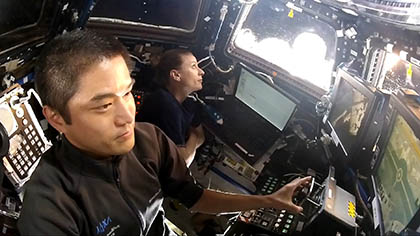ISS/Kibo Monthly News: August, 2016
Last Updated: September 28, 2016
Topic of the Month
Onboard activities of Astronaut Takuya Onishi
Astronaut Takuya Onishi was busy in August conducting science/medical experiments and tasks related to the Dragon spacecraft (SpaceX CRS-9), and supporting an Extravehicular Activity (EVA).
As medical experiments require the acquisition of data at fixed intervals, Onishi performed eye examinations and weight and body measurements, obtained blood samples, ran electrocardiograms and cardiac ultrasounds, and measured heart rates and amounts of exercise. When his fellow crewmates conduct experiments, he supports data acquisition and vice versa.
Onishi was also involved in tasks related to the return of the Dragon spacecraft. According to the packing list, he collected goods to be returned to Earth from all the modules and fixed the goods to predetermined points in the Dragon’s capsule. Then prior to Dragon’s unberthing, Onishi closed the hatch, disconnected cables, and checked for any leaks.
The Dragon spacecraft was unberthed on August 26 from Harmony (Node 2) by the Space Station Remote Manipulator System (SSRMS) that was maneuvered by the ground team and then released by Onishi and Rubins’ SSRMS operation.
The Dragon spacecraft later splashed down in the Pacific Ocean off the southwest coast of California on August 27.
NASA Administrator Charles Bolden visits the Tsukuba Space Center

JAXA President Naoki Okumura and NASA Administrator Charles Bolden pose for a photo in front of Kibo’s MCR (Credit:JAXA)
On August 5, NASA Administrator Charles Bolden visited the Tsukuba Space Center (TKSC) for the first time after assuming Administrator and observed the laboratories used for experiments conducted in Kibo and Kibo’s newly renovated Mission Control Room (MCR).
Mr. Bolden expressed his gratitude for the close relationship between the U.S. and Japan and the Japanese government’s agreement to an extension of ISS operations, and also conveyed his expectations for Japan to continue playing an important role in the field of space development.
Kibo this Month
JAXA’s ongoing medical experiment–“Multi-omics analysis of human-microbial metabolic cross-talk in the space ecosystem” (Multi Omics)
The space environment features microgravity, a closed environment, and radiation that can cause physiological changes resulting in bone loss, muscular atrophy, sleep disorders, and immune impairment, the symptoms of which are similar to those of aging.
Onishi obtained samples of saliva and other samples for storage in the Minus Eighty degree Celsius Laboratory Freezer for ISS (MELFI). These samples will later be returned to Earth for analysis.
The results will contribute to the development of preventive medicines and enhanced health for the elderly.
Biological Rhythms 48
“The Effect of Long-term Microgravity Exposure on Cardiac Autonomic Function by Analyzing 24-hour Electrocardiogram” (Biological Rhythms) is used to comprehensively evaluate the electrical activity of cardiac autonomic nerves and the biological rhythms between wakefulness and sleep, by recording an electrocardiogram for 48 hours and activities for 96 hours.
To record an electrocardiogram, a portable Holter monitor is used to record the body’s inner clock (called biological rhythms). In addition, Actiwatch, a wristwatch-type activity monitor, is used to record 96 hours of activities.
For this Japanese experimental theme, Japanese astronauts as well as international partner astronauts cooperate and provide data with this program.
Installation of the NanoRacks External Platform
The NanoRacks External Platform (NREP) developed by NanoRacks LLC in the U.S. is the first commercial exposed platform, and had been stored in the ISS since being delivered by the H-II Transfer Vehicle KOUNOTORI5.
Onishi assembled NREP and then pulled it outside through Kibo’s airlock. NREP was then installed in the Kibo’s Exposed Facility (EF) by the ground team using Kibo’s robotic arm (Japanese Experiment Module Remote Manipulator System: JEMRMS).
ISS this Month
Installation of the International Docking Adapter completed
From August 19-20, an Extravehicular Activity (U.S. EVA-36) was performed by U.S. astronauts Jeffrey Williams and Kathleen Rubins.
During the EVA, the second International Docking Adapter (IDA-2) that will enable the dockings of future spacecraft was installed to Harmony (Node 2) in the travel direction of the ISS.
Prior to the EVA, IDA-2 had been removed from the trunk of the Dragon spacecraft and then transferred in front of Node 2 by the SSRMS operated from the ground. During the EVA that lasted 5 hours, 58 minutes, the two spacewalkers installed IDA-2 on the PMA-2 and connected the power and data cables.
During the EVA that lasted 5 hours, 58 minutes, the two spacewalkers installed IDA-2 on the PMA-2 and connected the power and data cables.






Comments are closed.